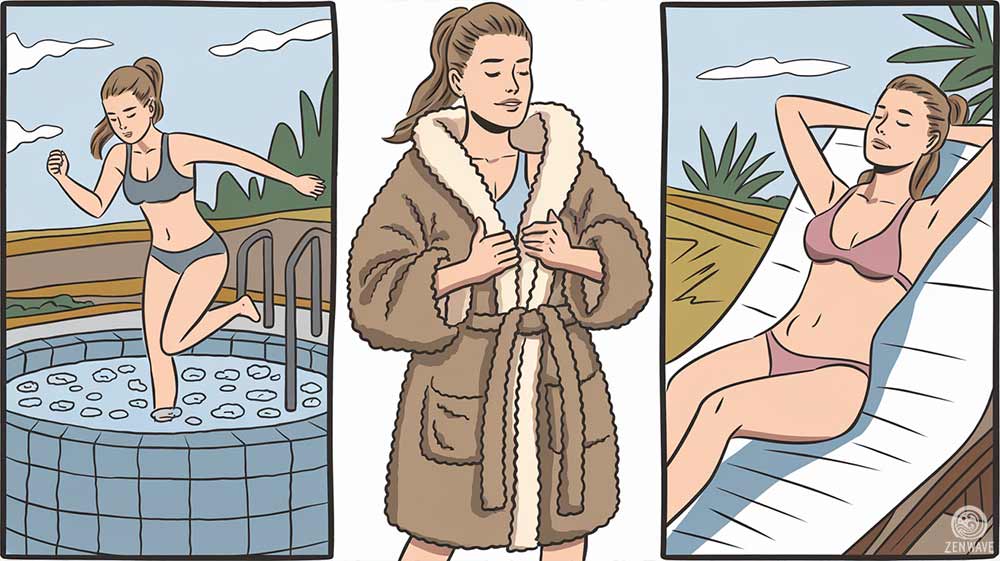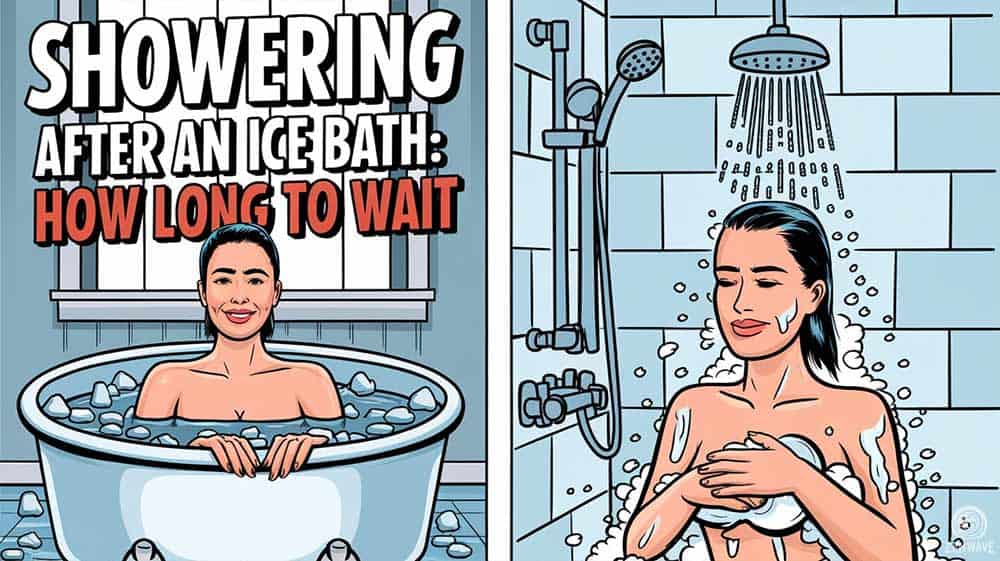The urge to jump into a hot shower immediately after an ice bath is tempting, but it could undermine the benefits of your cold therapy and poses additional risks, such as after drop.
This article examines the critical post-ice bath period, exploring why timing your shower matters and how long you should wait. We’ll discuss the physiological effects of transitioning from cold to hot, outline recommended waiting periods, and offer alternative warming methods.
Understanding these post-bath practices will help you optimize recovery while avoiding potential risks.
Why You Should Wait to Shower After an Ice Bath
The period immediately following your ice bath is crucial for maximizing its benefits. While your body might crave warmth, the physiological processes triggered by cold exposure need time to complete.
Let’s examine the specific reasons why patience is key:
Preserving the Benefits of Cold Exposure
- Vasoconstriction and Vasodilation: Ice baths cause your blood vessels to constrict, reducing inflammation and swelling. When you exit the bath, your vessels gradually dilate, increasing blood flow and flushing toxins from your muscles. A hot shower too soon can disrupt this natural process.
- Inflammation Reduction: The cold exposure helps reduce inflammation in your muscles and joints. Jumping into a hot shower can counteract this effect, potentially diminishing the ice bath’s benefits for muscle recovery and pain relief.
Avoiding Physiological Shock
- Cardiovascular Stress: The sudden shift from cold to hot can put stress on your cardiovascular system. This rapid change in temperature can lead to lightheadedness, dizziness, or even fainting, especially for those with underlying heart conditions.
- After Drop Phenomenon: There’s a risk of “after drop,” where your core body temperature continues to decrease even after leaving the ice bath. A hot shower can mask this effect, potentially leading to a dangerous drop in body temperature without you realizing it. To learn more about this critical safety consideration, read our detailed article on the after drop phenomenon.
Maximizing Recovery and Adaptation
- Natural Warming Process: Allowing your body to warm up naturally helps stabilize physiological responses and may contribute to long-term cold tolerance.
- Enhanced Circulation: The gradual warming process after an ice bath can promote better overall circulation, aiding in recovery and toxin removal.
By resisting the immediate urge for warmth, you allow these physiological processes to run their course. This patience can lead to more effective recovery, reduced inflammation, and better overall results from your cold therapy routine. The key is to view the post-ice bath period as an integral part of the therapy, rather than just an uncomfortable wait.
Recommended Waiting Period After an Ice Bath
Now that we understand why waiting is crucial, the next question is: how long should you wait? While the ideal duration can vary based on individual factors, there are general guidelines to follow and signs to watch for.
To maximize the health benefits of your ice bath and minimize potential risks, we generally recommend:
- Wait at least 20-30 minutes before taking a hot shower
- Allow your body to warm up naturally to room temperature
- Ensure you’ve stopped shivering and your extremities feel warm
Signs you’re ready for a shower:
- You feel comfortable at room temperature
- Your skin no longer feels chilled
- You’re not experiencing any dizziness or lightheadedness
Remember, individual factors like body composition, ice bath duration, and ambient temperature can influence the ideal waiting time. Always listen to your body and adjust accordingly.
Alternative Warming Methods After an Ice Bath

While waiting for your body to naturally warm up after an ice bath, you might be wondering how to make the process more comfortable without compromising the benefits.
Here are several gentle, gradual warming methods that support your body’s natural recovery process:
- Light Exercise: Engage in mild physical activity like walking, stretching, or gentle yoga to naturally increase blood flow and body temperature. The “Horse Stance” from the Wim Hof Method is particularly effective for promoting circulation and focus.
- Warm Clothing: After thoroughly drying off, put on warm, dry layers of clothing. Choose breathable fabrics to help your body retain heat without trapping moisture against your skin.
- Sunbathing: If weather permits, spend some time in direct sunlight. This natural warmth can help raise your body temperature gradually and comfortably.
- Warm Beverages: Sip on warm (not hot) drinks like herbal tea, coffee, or broth. This helps warm you from the inside out and aids in rehydration. Drinks containing carbohydrates can be especially beneficial, as cold exposure depletes glucose stores more quickly.
- Gentle Movement: Perform light, rhythmic movements like arm circles or slow jogging in place to encourage blood flow without overexerting yourself.
- Warm Environment: Move to a room with a comfortable ambient temperature. Avoid extreme temperature changes by staying away from very hot or cold areas.
- Gradual Exposure: If you do choose to shower, start with lukewarm water and gradually increase the temperature as your body adjusts.
These methods allow you to actively support your body’s recovery while adhering to the important principle of gradual warming. Listen to your body and adjust these methods as needed for your comfort and safety.
For more detailed guidance, see our article on what to do after a cold plunge.
Contrast Therapy: An Exception to the Rule
While we’ve emphasized the importance of waiting after an ice bath, there’s a notable exception to this rule: contrast therapy.
Contrast therapy, the practice of alternating between hot and cold temperatures, is a powerful recovery method that breaks the traditional rule of waiting after an ice bath. This technique intentionally alternates temperatures to manipulate blood flow, leveraging the body’s natural vascular response to enhance recovery.
Unlike unintentional rewarming, contrast therapy is carefully designed to control these temperature shifts, typically taking place in a safe, structured setting that minimizes the risks associated with sudden changes.
By combining both heat and cold, contrast therapy offers unique dual benefits, including improved circulation and more effective inflammation reduction compared to cold therapy alone.
Starting with Heat
Heat serves as the first phase of contrast therapy, and it’s more than just a warm-up.
- Prepares the Body for Cold Exposure: Heat exposure, such as sitting in a sauna or hot bath, dilates your blood vessels, allowing more blood to flow to your muscles and tissues. This primes your body for the cold phase that follows, ensuring the cold shock doesn’t feel as abrupt or uncomfortable
- Maximizes Circulation Cycles: The shift from heat to cold causes your blood vessels to go from dilated (open) to constricted (tight). This cycle of expansion and contraction, often called “vascular gymnastics,” stimulates circulation in ways that cold exposure alone cannot achieve. This helps to move out waste products like lactic acid while bringing in oxygen-rich blood to aid recovery
- Increases Cold Tolerance: By starting with heat, your body becomes more resilient when you transition into cold temperatures. The pre-warming effect can make the cold exposure feel less intense, allowing you to stay in the cold longer without feeling overwhelmed.
Ending with Cold
The cold phase is not just the final step but the key to locking in the benefits of contrast therapy.
- Seals in Anti-Inflammatory Effects: Finishing with cold closes the blood vessels back up, reducing swelling and locking in the anti-inflammatory effects of the session. This step helps to minimize soreness and muscle fatigue after intense workouts.
- Stimulates Faster Recovery: Cold exposure at the end of the session promotes a deeper recovery process, reducing the likelihood of delayed onset muscle soreness (DOMS) and speeding up overall healing.
- Aligns with Natural Warming: Rather than using heat to warm back up immediately after cold therapy (which could undo the benefits), ending with cold encourages your body to gradually return to its natural temperature. This slow rewarming process is safer and more aligned with your body’s natural rhythms.
Wrapping it Up
Timing your shower after an ice bath is crucial for maximizing the benefits of cold therapy while ensuring your safety. Generally, waiting 20-30 minutes allows your body to naturally warm up and complete important physiological processes. During this time, consider using gentle warming methods like light movement or warm clothing.
Remember that individual factors can influence the ideal waiting time, so always listen to your body. Whether you’re sticking to traditional ice bath recovery or exploring contrast therapy, understanding the science behind these practices will help you make informed decisions about your post-ice bath routine.

